Copper Slag Blended Cement: An Environmental Sustainable Approach for Cement Industry in India
Jagmeet Singh 1 * , Manpreet Kaur 1 and Jaspal Singh1
1
Department of Civil Engineering,
Punjab Agricultural University,
Ludhiana,
India
Corresponding author Email: jagmeet.dhanoa.99@gmail.com
DOI: http://dx.doi.org/10.12944/CWE.11.1.23
Indian cement industry is facing environmental issue of emission of carbon dioxide (CO2), a greenhouse gas. Blended cements including supplementary cementitious materials are substitute of Portland cement to reduce CO2 emission. The present paper investigates theappropriateness of copper slag (CS) as supplementary cementitious material. Strength properties and hydration of mixes were determined at different replacement levels of CS with cement. Compressive, flexural and tensile strength of each mix was found out at different curing periods. The hydration of cement was investigated through X-ray diffraction (XRD). The strength test results showed that substitution of up to 20% of CS can significantly replace Portland cement.XRD test results were corresponding to strength test results. The present study encourages the utilization of CS as supplementary cementitious material to make economical and environmentally sustainable blended cement
Copy the following to cite this article:
Singh J, Singh J, Kaur M. Copper Slag Blended Cement: An Environmental Sustainable Approach for Cement Industry in India. Curr World Environ 2016;11(1) DOI:http://dx.doi.org/10.12944/CWE.11.1.23
Copy the following to cite this URL:
Singh J, Singh J, Kaur M. Copper Slag Blended Cement: An Environmental Sustainable Approach for Cement Industry in India. Curr World Environ 2016;11(1). Available from: http://www.cwejournal.org/?p=13567
Download article (pdf)
Citation Manager
Publish History
Select type of program for download
| Endnote EndNote format (Mac & Win) | |
| Reference Manager Ris format (Win only) | |
| Procite Ris format (Win only) | |
| Medlars Format | |
| RefWorks Format RefWorks format (Mac & Win) | |
| BibTex Format BibTex format (Mac & Win) |
Article Publishing History
| Received: | 2016-02-01 |
|---|---|
| Accepted: | 2016-02-18 |
Introduction
Cement industry is the fastest growing industry in India.As per the economic advisor, Department of Industrial Policy & Promotion (DIPP),during the year 2013-14 in India, cement production was 255.57 million tons. But, cementindustry has facing many environmental issues. The main environmental issue associated with cement industry is emission of carbon dioxide (CO2), a greenhouse gas. Cement industry generates significant amount of CO2. Producing a ton of Portland cementgenerates nearly a ton of CO21. Currently, large production of Portland cement in India releases large amount of CO2 to environment.Supplementary cementitious materials are substitute of Portland cement to reduce CO2 emission. These materials replace some amount of Portland cement, without affecting its mechanical properties.Different industrial wastes likes slag and metakolincan exercise as supplementary cementitious materials2. Portland cement which includes supplementary cementitious material is blended cement.
CS is a waste material generates from refining of copper,and may have the potential to be used as supplementary cementitious materials in cement industry3. In India approximately six million tons of CS generates annually4. Various investigations have been carried out to determine the suitability ofCS as a partial replacement of cement.These investigations showed thatCS as cement replacement exhibited better strength and long-termproperties as compare to normal concrete batches5-9.However, in India, studies regarding exercise of CS in cement industry are rarely seen in literature. Therefore,in this study an attempt is made to determine the appropriateness of CS as supplementary cementitious material for the production of environmentally sustainable blended cement.
Materials
Cement
Ordinary Portland cement of 43 grade was used in this study.All properties of Ordinary Portland cement conformed to BIS 811210.
Fine and coarse aggregates
The fine aggregates used were river sand having a 4.75 mm nominal maximum size. The coarse aggregate used were crushed stone having a 20 mm nominal maximum size.Specific gravity of fine and coarse aggregates calculated as per BIS 238611 was 2.64 and 2.60 respectively. Fine aggregates conformed to grading zone II as per BIS 38312.The grading requirement of coarse aggregates was in accordance with BIS 38312.
Copper slag (CS)
CS obtained from Synco Industries Limited (Jodhpur, Rajasthan) was used in this study.CS was black in color and irregular in shape. Specific gravity of CS was 3.51. It was ground in to fine powder and sieved below 90 micron sieve to attain similar fineness as cement. Fineness of CS determined as per BIS 403113 using Blaine’ specific surface area method was 325 m2/kg. The chemical properties of CS are given in Table 1.
Table 1: Chemical properties of CS
|
Chemical component |
% of Chemical component |
|
Cu |
0.70% |
|
SiO2 |
28% |
|
Fe2O3 |
57.5% |
|
Al2O3 |
4% |
|
CaO |
2.5% |
|
MgO |
1.2% |
|
Fe3O4 |
4% |
|
S |
0.3% |
|
Moisture |
1.8% |
Methods
Mix proportions and sample preparation
In this study, the one reference mix C1 was designed according to BIS 1026214as plain concrete. Further four mixes were prepared other than reference mix at different replacement levels of copper slag (5%, 10%, 15% &20%) with cement. Mix proportions of concrete mixes are given in Table 2. The quantities of cement, coarse aggregates, fine aggregates, copper slag and water for each mix were weighed separately. The cement and copper slag were mixed dry. Fine aggregates were mixed to this mixture in dry form. The coarse aggregates were mixed to get uniform distribution throughout the batch. Water was added to the mix and then mixed thoroughly for 3 to 4 minutes in a proper mechanical mixer.
Table 2: Mix proportions of concrete mixes
|
Mixes |
CS % |
CS (kg/m3) |
Cement (kg/m3) |
FA (kg/m3) |
CA (kg/m3) |
Water (L/m3) |
W/B ratio |
|
C1 |
0 |
0 |
432 |
548 |
1167 |
186 |
0.43 |
|
C2 |
5 |
21.6 |
410.4 |
548 |
1167 |
186 |
0.43 |
|
C3 |
10 |
43.2 |
388.8 |
548 |
1167 |
186 |
0.43 |
|
C4 |
15 |
64.8 |
367.2 |
548 |
1167 |
186 |
0.43 |
|
C5 |
20 |
86.4 |
345.6 |
548 |
1167 |
186 |
0.43 |
CS = Copper slag, FA = Fine aggregates, CA = Coarse aggregates, W/B = Water/ Binder
Testing Procedure
The compressive and split tensile strength of each mix was found out from cube specimens of 150 mm X 150 mm X 150 mm in size. The flexural strength of each mix was calculated from prism specimens of 150 mm X 150 mm X 700 mm in size. The compressive and flexural strength of specimens was tested according to BIS 51615. The splitting tensile strength of specimens was tested according to BIS 581616.All strength tests were performed on universal testing machine after 7, 28 and 90 days of curing.
Hydration study using XRD
The degree of hydration of cement was investigated by XRD. The diffracted peaks of different hydration products can be found out using XRD. The degree of hydration of cement can be observed from these diffracted peaks. The intensity of these diffracted peaks plotted against the diffraction angle 2θ (degrees). The intensity was measured in counts per second (cps). The X- ray diffraction test was performed on samples of cementitious powder of mixes with blends;C1 (0% CS), C3 (10% CS) and C5 (20% CS). The samples of cementitious powder were collected from the remnant of concrete specimens after28 and 90-days compressive strength test. The X-ray diffractograms of different samples were recorded on Panalytical X’Pert PRO with Bragg–Brentano geometry. Powder samples were loaded on aluminum sample holder having dimensions 2cm X 1·5cm X 0·2 cm. The measurements were carried out in a 2θ range of 10.0066° to 99.9846° with a step width of 0.0130°.
Results and Discussion
Compressive strength
The average 7th, 28th and 90th day compressive strength of different mixes are given in Table 3 and shown in Fig. 1. The results show that, 7 and 28 day compressive strength of concrete is decreased with increase in CS content in mix due to noncementitious properties of CS. The small quantity of CaOin CS (Table 1) does not possess any cementitious properties. Thus CS does not bind the mix; it disperses the mix and reduces the compressive strength of concrete. However, the 90 day compressive strength of concrete is increased with increase in CS content in mix (Fig. 1). The presence of SiO2 in CS (Table1), initial the pozzolanic reaction and increased the compressive strength. At higher percentage of CS (20% CS), the compressive strength increased from 28.30 MPa at the 28th day to 47.93 MPa at the 90th day (Table 3). At the 90th day, 20% of CS showed maximum compressive strength of 47.93 MPa. It is noted that strength gain took place after 28th day curing due to initiate of pozzolanicreactions ofC S. The compressive strength test results showed that up to 20% of CS significantly replace Portland cement and provides environmental sustainable blended cement.
Table 3: Test results for compressive, flexural and splitting tensile strength of concrete (MPa)
|
Mix |
(fc)7 days |
(fc)28 days |
(fc)90 days |
(fb)7 days |
(fb)28 days |
(fb)90 days |
(fct)7 days |
(fct)28 days |
(fct)90 days |
|
C1 |
30.85 |
43.01 |
46.09 |
4.27 |
5.10 |
5.48 |
3.67 |
4.59 |
4.71 |
|
C2 |
30.60 |
41.74 |
46.86 |
4.20 |
4.97 |
5.62 |
3.58 |
4.51 |
4.78 |
|
C3 |
28.98 |
40.37 |
47.13 |
4.11 |
4.89 |
5.83 |
3.51 |
4.48 |
4.81 |
|
C4 |
23.34 |
32.85 |
47.40 |
3.71 |
4.41 |
5.41 |
3.37 |
4.03 |
4.62 |
|
C5 |
18.50 |
28.30 |
47.93 |
3.21 |
4.09 |
4.79 |
3.03 |
3.75 |
4.53 |
fc = Compressive strength, fb = Flexural strength, fct = Splitting tensile strength
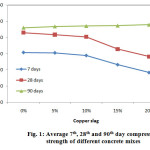 |
|
Flexural and splitting tensile strength of concrete
The average 7th, 28th and 90th day flexural strength of different concrete mixes are given in Table 3 and shown in Fig. 2.The average 7th, 28th and 90th day splitting tensile strength of different concrete mixes are given in Table 3 and shown in Fig. 3.The results show that, 7th and 28th day flexural and splitting tensile strength of concrete is decreased with increase in CS content in mix. However, the 90th day flexural and splitting tensile strength of concrete was increased as CS content increases in mix as shown in Fig. 2 and 3 respectively. At the 90th day, 20% of CS showed maximum flexural and splitting tensile strength of 5.93 MPa and 5.03 MPa respectively. It was found that the flexural and splitting tensile strength test result was related to the compressive strength test results.
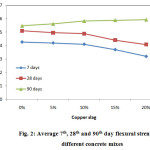 |
|
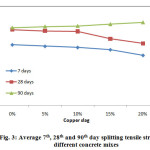 |
|
Hydration study using XRD
XRD test was performed on samples of cementitious powder of mixes C1 (0% CS), C3 (10% CS) and C5 (20% CS). The samples of cementitious powder were collected from the remnants of concrete specimens after 28th and 90th day compressive strength test. The XRD test results are shown in Fig. 4 to 9. All the mixes consist the peaks of quartz, portlandite and alite on 2θ scale as shown in Fig. 4 to 9.But the portlandite is the main hydration product during the hydration of cement. The peaks of portlandite in all mixes represent the degree of hydration of cement. The major peaks of portlandite were observed at 18.1° and 34.1°. The peak of portlandite at 18.1° was overlapped with the peak of alite. The peak of portlandite at 34.1° was the highest among all the peaks of portlandite in all mixes. The mix C1, at 28th day, show the highest intensity of portlandite peaks in Fig. 4.But,the mixes C3 and C5, at 28th day show low intensity of portlandite peaks as compare to mix C1 in Fig. 5 and 6 respectively. The low intensity of portlandite peaks in mixes C3 and C5represents lower rate of hydration due to the presence of CS. The non cementitious behavior of CS does not contribute in the hydration of cement and reduce the intensity of portlandite peaks. The XRD pattern of mixes C1, C3 and C5, at 90th day is shown in Fig. 7, 8 and 9 respectively. It was observed that, the intensity of portlandite peaks at 90th day is very less as compare to at 28th day in all mixes. The low intensity of portlandite peaks indicate the pozzolanicactivity of CS. The pozzolanic reaction of CS consumes significant amount of portlandite and increases the compressive strength of concrete. It was found that XRD test results were in agreement with the compressive strength test results.
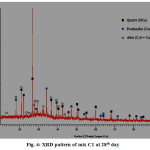 |
|
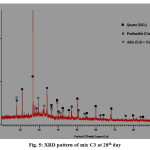 |
|
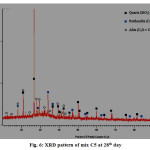 |
|
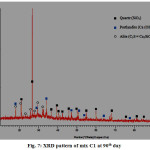 |
|
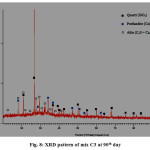 |
|
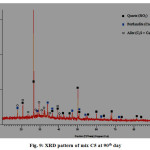 |
|
Acknowledgement
The author(s) acknowledge the support and help received from Department of Civil Engineering, Punjab Agricultural University, Ludhiana,Punjab, India.
References
- Rubenstein, M.Emissions from the Cement Industry.http://blogs.ei.columbia.edu/2012/05/09/emissions-from-the-cement-industry(Accessed on 1 July 2014).
- Toutanji, H., Delatte, N., Aggoun, S., Duval, R., and Danson, A. Effect of supplementary cementitious materials on the compressive strength and durability of short-term cured concrete. Cement Concrete Research, 34: 311–319 (2004)
CrossRef - Shi, C., Meyer, C., and Behnood, A. Utilization of copper slag in cement and concrete. Resources Conservation Recycling, 52: 1115-1120 (2008)
CrossRef - Narasimhan, T. E. Sterlite's copper slag waste finds new uses. http://www.businessstandard.com/article/companies/sterlite-s-copper-slag-waste-finds-new-uses-111041900105_1.html.(Accessed on 6 July 2014)
- Tixier, R., Devaguptapu, R., and Mobasher, B. The effect of copper slag on the hydration and mechanical properties of cementitious mixtures. Cement Concrete Research, 27(10): 1569–1580 (1997)
CrossRef - Arino, A. M., and Mobasher, B. Effect of ground copper slag on strength and toughness of cementitious mixes. ACI Material Journal, 96(1): 68-73(1999)
- Zain, M. F. M., Islam, M. N., Radin, S. S., and Yap, S. G. Cement-based solidification for the safe disposal of blasted copper slag. Cement Concrete Composites, 26(7): 845–851 (2004)
CrossRef - Moura, W. A., Gonçalves, J. P., and Lima, M. B. L. Copper slag waste as a supplementary cementing material to concrete. Journal of Material Science, 42(7): 2226-2230 (2007)
CrossRef - Sanchez de Rojas, M. I., Rivera, J., Frias, M., and Marin, F. Use of recycled copper slag for blended cements. Journal of Chemical Technology and Biotechnology, 83(3): 209-217 (2008)
CrossRef - BIS 8112. Specification for 43 grade Ordinary Portland Cement. Bureau of Indian Standard, New Delhi (1989)
- BIS 2386. Methods of Test for Aggregates for Concrete. Bureau of Indian Standard, New Delhi (1963)
- BIS 383. Specification for Coarse and Fine Aggregates from Natural Sources for Concrete. Bureau of Indian Standard, New Delhi (1970)
- BIS 4031. Methods of Physical Tests for Hydraulic Cement. Bureau of Indian Standard, New Delhi (1988)
- BIS 10262. Recommended guidelines for concrete mix design. Bureau of Indian Standard, New Delhi (1982)
- BIS 516. Methods of tests for strength of concrete. Bureau of Indian Standard, New Delhi (1959)
- BIS 5816. Splitting tensile strength of concrete -Method of test. Bureau of Indian Standard, New Delhi (1999)






